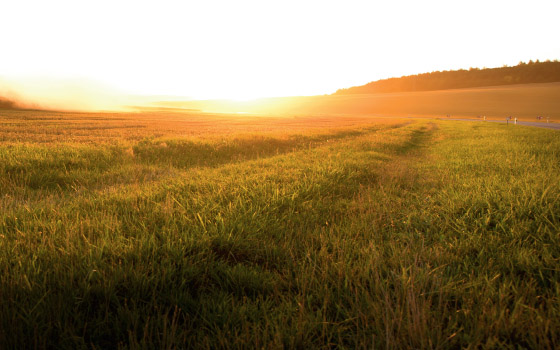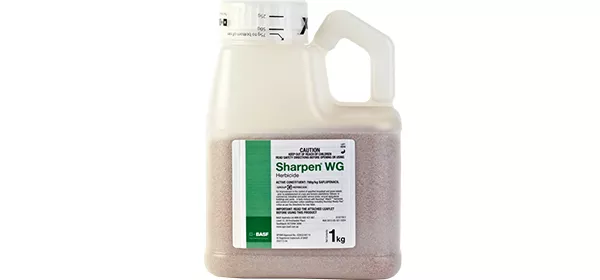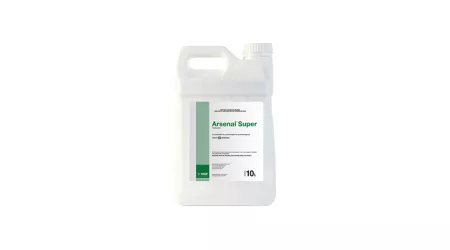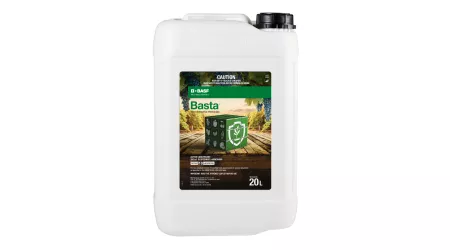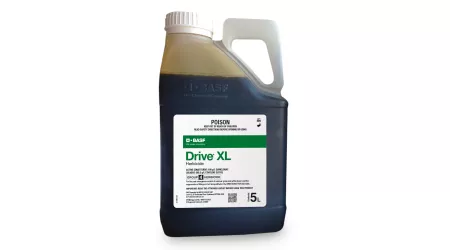Key benefits
- Fast knockdown of 32 hard-to-kill broadleaf weeds
- Enormous seed set reductions targeting the weed seed bank and secondary germinations for extended weed control
- Provides rapid burndown of weeds within 72 hours of application
- Suitable as a standalone or tank mix partner - Sharpen is compatible with BASF’s Arsenal Super® and Basta® herbicides
- Suitable for spraying in drift sensitive areas due to its low volatility
How it works
Sharpen® is a fast-acting contact herbicide and helps control weeds through a process of membrane disruption. The foliar uptake of Sharpen is rapid and plant desiccation can occur within 4 days of application. Application should target small, actively growing weeds. Subsequent germinations will not be controlled.
In most situations, Sharpen should be applied with a conventional boom sprayer with mechanical or bypass agitation in 80–250 L/ha water. Use higher water volumes if the weed infestation is dense or as weeds increase in size. Refer to label for further details.
Crop suitability
-
Agricultural buildings / areas
AmaranthAmsinckiaAnnual grassAustralian crassulaBarley grassBindweed / climbing buckwheatBlackberry nightshadeBrome grassCaltropCapeweedCharlockCommon cat's earCow peaCrassulaFat henFleabaneHeliotropIndian hedge mustardKhaki weedKochiaMarshmallow / Small flowered mallowMedicsMuskweedPaterson's cursePenny cressPrickly lettuceScarlet pimpernelShepherd's purseSilver grassSlender thistleSnoutbeanSow thistle / Milk thistleSpiny emexStinging nettleStorksbillVolunteer canolaVolunteer cottonVolunteer pulse crops including lupin and chickpeaVolunteer wild oatsWild gooseberryWild radishWild turnip / turnip weedWireweed -
Commercial buildings / areas
AmaranthAmsinckiaAnnual grassAustralian crassulaBarley grassBindweed / climbing buckwheatBlackberry nightshadeBrome grassCaltropCapeweedCharlockCommon cat's earCow peaCrassulaFat henFleabaneHeliotropIndian hedge mustardKhaki weedKochiaMarshmallow / Small flowered mallowMedicsMuskweedPaterson's cursePenny cressPrickly lettuceScarlet pimpernelShepherd's purseSilver grassSlender thistleSnoutbeanSow thistle / Milk thistleSpiny emexStinging nettleStorksbillVolunteer canolaVolunteer cottonVolunteer pulse crops including lupin and chickpeaVolunteer wild oatsWild gooseberryWild radishWild turnip / turnip weedWireweed -
Industrial buildings / areas
AmaranthAmsinckiaAnnual grassAustralian crassulaBarley grassBindweed / climbing buckwheatBlackberry nightshadeBrome grassCaltropCapeweedCharlockCommon cat's earCow peaCrassulaFat henFleabaneHeliotropIndian hedge mustardKhaki weedKochiaMarshmallow / Small flowered mallowMedicsMuskweedPaterson's cursePenny cressPrickly lettuceScarlet pimpernelShepherd's purseSilver grassSlender thistleSnoutbeanSow thistle / Milk thistleSpiny emexStinging nettleStorksbillVolunteer canolaVolunteer cottonVolunteer pulse crops including lupin and chickpeaVolunteer wild oatsWild gooseberryWild radishWild turnip / turnip weedWireweed -
Public service buildings / areas
AmaranthAmsinckiaAnnual grassAustralian crassulaBarley grassBindweed / climbing buckwheatBlackberry nightshadeBrome grassCaltropCapeweedCharlockCommon cat's earCow peaCrassulaFat henFleabaneHeliotropIndian hedge mustardKhaki weedKochiaMarshmallow / Small flowered mallowMedicsMuskweedPaterson's cursePenny cressPrickly lettuceScarlet pimpernelShepherd's purseSilver grassSlender thistleSnoutbeanSow thistle / Milk thistleSpiny emexStinging nettleStorksbillVolunteer canolaVolunteer cottonVolunteer pulse crops including lupin and chickpeaVolunteer wild oatsWild gooseberryWild radishWild turnip / turnip weedWireweed
